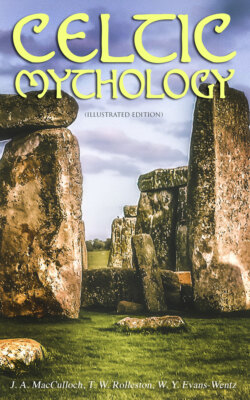Читать книгу CELTIC MYTHOLOGY (Illustrated Edition) - T. W. Rolleston - Страница 52
Egyptian and “Celtic” Ideas of Immortality
ОглавлениеThe facts at present known do not, I think, justify us in framing any theory as to the actual historical relation of the dolmen-builders of Western Europe with the people who created the wonderful religion and civilisation of ancient Egypt. But when we consider all the lines of evidence that converge in this direction it seems clear that there was such a relation. Egypt was the classic land of religious symbolism. It gave to Europe the most beautiful and most popular of all its religious symbols, that of the divine mother and child29. I believe that it also gave to the primitive inhabitants of Western Europe the profound symbol of the voyaging spirits guided to the world of the dead by the God of Light.
The religion of Egypt, above that of any people whose ideas we know to have been developed in times so ancient, centred on the doctrine of a future life. The palatial and stupendous tombs, the elaborate ritual, the imposing mythology, the immense exaltation of the priestly caste, all these features of Egyptian culture were intimately connected with their doctrine of the immortality of the soul.
To the Egyptian the disembodied soul was no shadowy simulacrum, as the classical nations believed—the future life was a mere prolongation of the present; the just man, when he had won his place in it, found himself among his relatives, his friends, his workpeople, with tasks and enjoyments very much like those of earth. The doom of the wicked was annihilation; he fell a victim to the invisible monster called the Eater of the Dead.
Now when the classical nations first began to take an interest in the ideas of the Celts the thing that principally struck them was the Celtic belief in immortality, which the Gauls said was “handed down by the Druids.” The classical nations believed in immortality; but what a picture does Homer, the Bible of the Greeks, give of the lost, degraded, dehumanised creatures which represented the departed souls of men! Take, as one example, the description of the spirits of the suitors slain by Odysseus as Hermes conducts them to the Underworld:
“Now were summoned the souls of the dead by Cyllenian Hermes....
Touched by the wand they awoke, and obeyed him and followed him, squealing,
Even as bats in the dark, mysterious depths of a cavern
Squeal as they flutter around, should one from the cluster be fallen
Where from the rock suspended they hung, all clinging together;
So did the souls flock squealing behind him, as Hermes the Helper
Guided them down to the gloom through dank and mouldering pathways.”30
The classical writers felt rightly that the Celtic idea of immortality was something altogether different from this. It was both loftier and more realistic; it implied a true persistence of the living man, as he was at present, in all his human relations. They noted with surprise that the Celt would lend money on a promissory note for repayment in the next world.31 That is an absolutely Egyptian conception. And this very analogy occurred to Diodorus in writing of the Celtic idea of immortality—it was like nothing that he knew of out of Egypt.32
